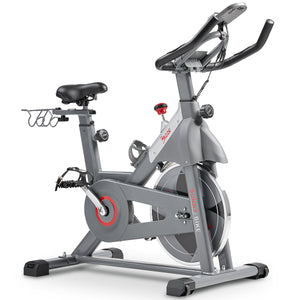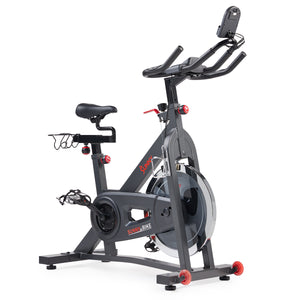Published on 2/5/2019, Updated on 10/6/2021
If you’ve looked at exercise bikes, you’ve likely seen varying flywheel sizes. Some exercise bike flywheels are heavy and upwards of 40 pounds. Other flywheels are much lighter, maxing out around 8 pounds.
Keep reading to learn more about your exercise bike flywheel weight differences and effects, and what having a heavier or lighter flywheel weight means for your ride.
What is a Flywheel?
You may have heard about a flywheel on an indoor cycle bike before, but what exactly is it? A flywheel is a mechanism by which fitness equipment can create a force for you to work against as you push or pedal against it.
Upright bikes, recumbent bikes, and ellipticals often use flywheels as a part of their mechanical system, although you usually won’t see them because they’re covered.
On cycle bikes, it’s super easy to identify a flywheel because it’s the circular disc located either on the front or back of the bike.
The flywheel is connected by either a chain (chain drive) or belt (belt drive) - As you engage the pedal, the chain or belt moves, which in turn spins the flywheel, allowing you to ride the bike.
While flywheels come in a variety of weights ranging from light to heavy - it’s important to note the weight of the flywheel doesn't impact the amount of resistance or tension you experience while cycling on an indoor cycle bike.
How Does Flywheel Change Your Workout Experience?
Cycle bike flywheels always work in tandem with some sort of resistance system - whether friction generated resistance (created by a felt or leather pad applied directly to the flywheel) or magnetic resistance (created by applying a magnetic force to the flywheel).
Resistance applied to the flywheel is what will make your workout feel easier or harder. So, if you’re interested in finding a bike that will provide an intense workout, the resistance system is an important factor to consider.
When it comes to the flywheel, on the other hand, the general concern is its ability to build and maintain momentum, contributing to the overall feel of the ride for the user.
If you’re looking for a comfortable and smooth ride, then you’ll want to learn more about how the flywheel weight on your exercise bike can impact the feel of your ride.
Does Exercise Bike Flywheel Weight Matter?
Think back to when you learned to ride a bike as a kid. A bicycle is rarely quick to start; it takes a lot of pedaling force to get it up to full speed. And when it is up to speed, the momentum created by pedaling is what keeps the bike moving.
Riding an indoor exercise bike is very similar to riding an outdoor bicycle. Upon the first pedaling stroke, you’ll expend more energy getting the flywheel in motion; but once the flywheel is in motion, it’s all about keeping up the speed - this is called momentum.
To achieve a smooth feeling ride, a flywheel needs to generate a good amount of momentum. Momentum helps to eliminate pauses or gaps between pedal strokes, which can make your ride feel choppy and uncomfortable.
There are two cases in which it’s possible to generate momentum on a cycle bike.
The first is flywheel weight. Weight does have some effect on flywheel performance and movement. A heavier flywheel (20 LB+) is designed to build and maintain momentum. Basic physics teaches us that the heavier and faster an object is, the harder it is to stop (more on this later).
The second is flywheel speed. The faster a flywheel can rotate, or the more revolutions a flywheel is able to make during one pedal stroke, the easier you can build and maintain momentum.
However, faster flywheels are generally engineered lighter, which enables them to generate more speed than their heavier counterparts, and helps to produce a smooth, momentous feel.
Two Ways to Generate Flywheel Momentum
- Flywheel Weight - A heavier flywheel can generate smooth momentum
- Flywheel Speed - A faster flywheel can generate smooth momentum
So, to answer the question ‘Does Exercise Bike Flywheel Weight Matter?’ in short, yes, it absolutely does matter! However, whether a heavy or a light flywheel is better is a bit more complicated than a simple yes or no answer.
Heavy vs Lightweight Flywheels
A heavy, smooth flywheel or a light, fast flywheel are both good options when looking for a flywheel that generates a good amount of momentum for a comfortable ride. Both can be good factors to have in a quality bike, depending on how the bike is engineered.
Learn more about whether a heavy or light flywheel is a better match for you from this side-by-side flywheel weight comparison chart.
HEAVY VS. LIGHT EXERCISE FLYWHEEL WEIGHT COMPARISON CHART
| Heavy Flywheel | Light Flywheel |
|---|---|
|
|
Exercise Bikes with a Heavy Flywheel Weight
A cycle bike with a heavier flywheel will simulate a hard-to-start experience, just like an outdoor bike. What you’ll notice with a heavier flywheel is that it maintains its momentum throughout your ride, which helps to keep the pedals moving seamlessly.
Indoor cyclists who prefer a heavier flywheel enjoy the feel of an outdoor bicycle or studio cycling experience. Many people consider 40 LB to be ideal, but anything over 20+ pounds is going to be heavy enough to generate a good amount of momentum.
Most high-quality cycle bikes on the market with a smooth feel will incorporate a heavy flywheel system since these bikes are much easier to manufacture. If you’re interested in a bike with a heavy flywheel, there are tons of great options out there to choose from, and I encourage you to do your research.
Keep in mind; these bikes are harder to bring up and down in speed. It can be more jarring on the joints as you push or pull harder to get the pedals moving or to stop them in action.
If you choose a bike with a heavy flywheel, be gentle to your joints by taking time to slow to a stop, or consider using the emergency stop brake to bring the bike to a swift stop if needed.
You can find heavier flywheels in cycle bikes, such as our best-selling SF-B1002 Indoor Cycling Bike or the ever popular SF-B1851 Synergy Pro Magnetic Indoor Cycling Bike.
Exercise Bikes with a Light Flywheel Weight
If you’re looking for a bike that’s easier to start and stop and designed for high speed cycling, then a lighter flywheel may be right for you. Indoor cyclists that are looking to jump straight into action may enjoy lighter flywheels.
Light flywheels can be a bit gentler on the joints in comparison to their heavy counterparts because it requires less pressure on the joints to get pedaling. So, if you have achy joints or some trouble with joint pain, a lighter flywheel may be a good choice for you.
It’s important to note some bikes use a light flywheel to save money. Often these bikes are similarly geared as heavy flywheel bikes, so the design of the bike doesn’t allow the flywheel to move fast enough, which can result in an unnatural, jerky ride.
However, some bikes are engineered with a light flywheel on purpose. With these bikes, the flywheel is designed for speed, and the bike allows the flywheel to take a high number of revolutions per each pedal stroke.
These high-quality bikes result in a great deal of momentum and an incredibly smooth ride. It’s more expensive to produce a high-quality ride with a light flywheel design. Usually, these bikes run upward of $2000, which is why most popular bikes on the market opt to use a heavy flywheel to create smooth momentum.
The SF-B1709 Magnetic Indoor Cycling Bike is an incredible value for the quality of ride, designed with a light, high speed flywheel!
Is an Exercise Bike With a Heavy Flywheel Better?
Nope! As you’ve learned above, both heavy and light flywheels can provide a smooth, momentous riding experience that you’re looking for. It’s important to research the quality and review the bike before purchasing.
If you’re going for a heavy flywheel, I recommend a weight of 30 LB+, 40 LB for that studio cycle feel. If looking for a lightweight flywheel, do your research, and see what fits in your budget.
Remember, some lightweight flywheels are only designed that way to cut the cost of the product and will impact your riding experience in a negative way - whereas the SF-B1709 Magnetic Indoor Cycling Bike is designed to move fast and maintain momentum, making it a great choice for your home gym if you’re interested a bike with a lighter flywheel.
Will a Light or Heavy Flywheel Burn More Calories?
While heavier flywheels require more energy to get moving, that experience has little to do with how many calories you can burn while riding your bike.
For the most part, you’ll exert the most energy maintaining a set speed with applied resistance. The more resistance forced on your flywheel, the more calories you can expect to burn while keeping it in motion.
Not all resistance is the same. You’ll find bikes with contact resistance, such as felt and leather brake pads, as well as magnetic resistance.
The type of resistance on your bike will have a big impact on your workout experience and is an important specification to consider before purchasing an indoor exercise bike.
To learn more, be sure to read my article on cycle bike resistance: Magnetic Resistance vs. Other Types of Resistance for Cycle Bikes - Which is the Best For You?
So, Which Flywheel Should I Buy?
Whether you’re interested in a recumbent bike, upright bike, or cycle bike, the flywheel weight is an important factor to consider. You can get a great workout with both an exercise bike that has a heavy flywheel or a light flywheel.
Heavier flywheels can be ideal for individuals that prefer the feel of an outdoor bicycle, or studio cycling experience.
Lighter flywheels are great for the rider that’s ready to jump into action and may desire a bike that’s easier on the joints.
Just remember workout intensity is less about flywheel weight and more about applied resistance.
Always remember, the best exercise equipment is the one that gets you moving every day. So, find an indoor cycle bike that fits your budget and your home gym space, and you’ll be in business in no time!

Recommended Products




























Add Your Name & Email
Please enter your name and email to continue.We won’t display your email publicly.
3 comments
Hi Sydney, greetings from Venezuela. I am in the process of purchasing a spinning bike. Your article is very, very informative and pleasant to read. Do you consider a 29-pound to be good for a beginner? Do you consider it a heavy weight? Thank you.
What are the weight of different recumbent exercise bikes and how they affect the pedaling in the recumbent position. Do they make a recumbent with a light flywheel for easier pedaling for seniors or someone with arthritis in knees that is better.
I found the article Exercise Bike Flywheel Weight: Heavy or Lightweight Comparison very informative. Yet it didn’t address recumbent bikes with light weight flywheels with smooth rides. Can you recommend one in your line that is not going to cost me a mortgage payment please?